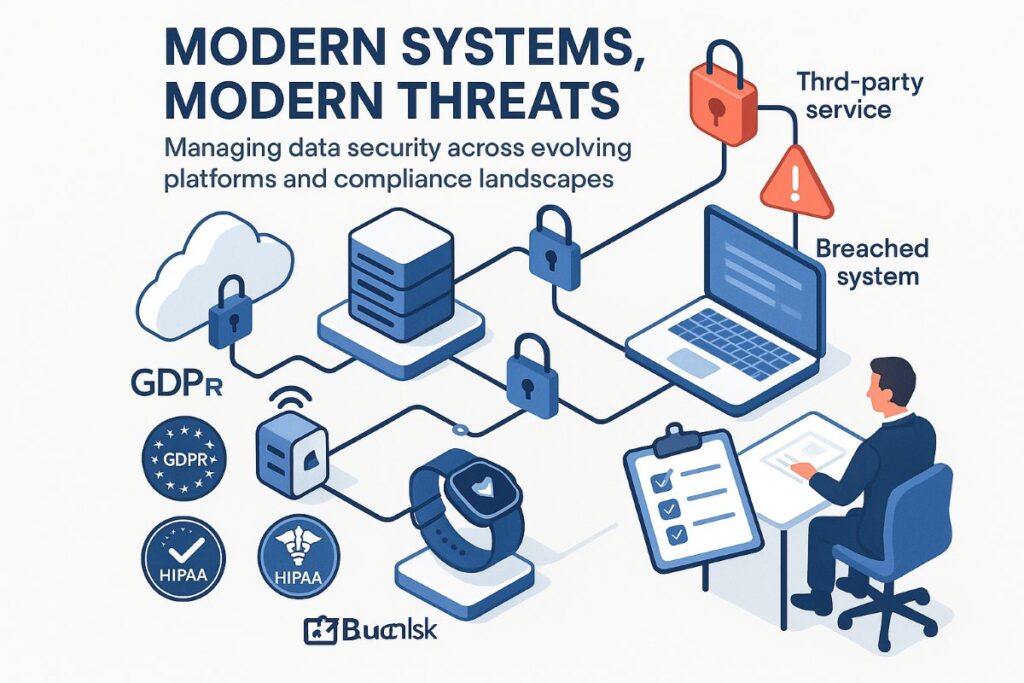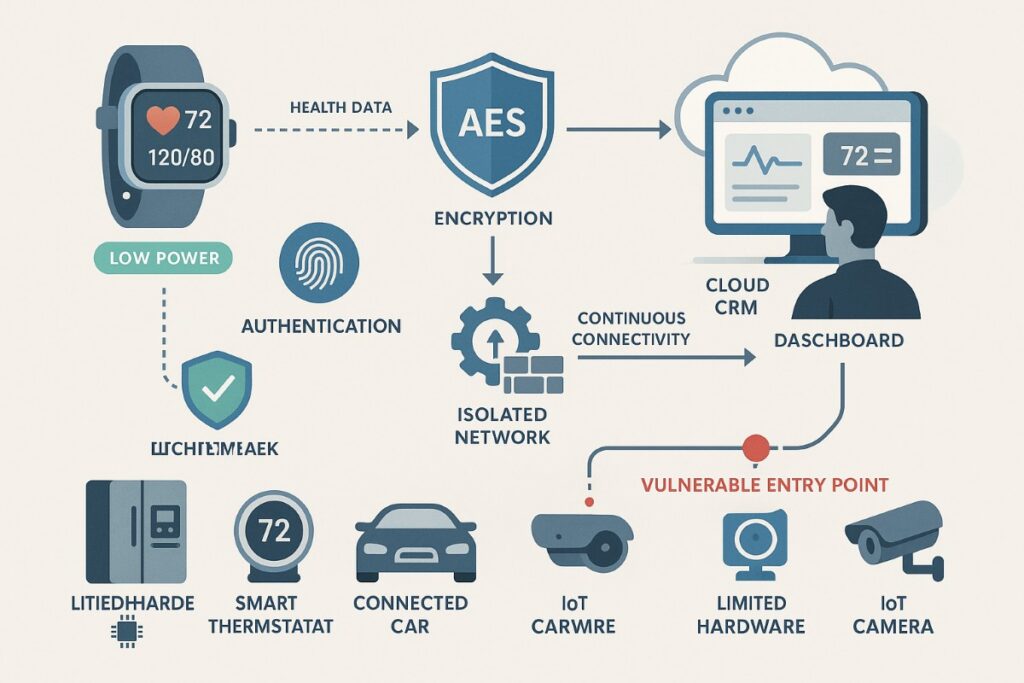Data security and data privacy in companies that handle sensitive data related to customers is significant in developing trust and satisfying the legal requirements. With the increased collection of data, especially by connected devices, including wearables and IoT-based systems, the need to protect that data has never been greater. Failure to protect the data of customers can not only be a costly affair but can also cause severe reputation damages.
In this article, written in collaboration with Embrox Solutions, we shall look into why data privacy and security is now a requirement in business today particularly as we consider embedded systems, IoT devices and CRM platforms. How the business world can address the challenge of ensuring that the data of their customers is safe and the most effective methods to implement effective data security will also be mentioned.
The Rising Significance of Data Privacy and Data Security

As there is a growth in technology, more information is being collected about the users. It can be either smartphones and fitness trackers, medical devices, or IoT sensors, and the resulting information tends to be highly sensitive, either health data or personal preferences. The larger the volume of information that businesses collect, the more attractive they become to cybercriminals and hence are valuable data breach targets.
The Information as a Resource
Information has proved to be an important asset in running businesses and decision making. It allows businesses to show customized experiences, sell more to customers, and improve services and products. However, together with this information, there can be stealing, abuse or information leakage. The issue of data security is significant to any business especially those in the healthcare, finance and retail industries because this aspect helps to keep valuable information secure and thus the business maintains customer confidence.
Incidents of rising cyber threats
Cases of data breaches and cyberattacks are on the increase and companies need to do all they can to secure their systems. For a deeper dive into how implementing security systems can boost protection, read this guide on strengthening data security. The proliferation of the complexity of systems, especially the development of the IoT devices and embedded systems introduces new vulnerabilities that can be exploited by hackers. A single vulnerability of a device or a system can lead to a significant violation of an entire network.
Regulatory Landscape
The regulatory environment of data privacy is becoming more stringent. Europe and the California Consumer Privacy Act (CCPA) are regulations that compel businesses to keep their data safe and provide transparency on how they process and use customer information. Failure to comply with these regulations can result in massive penalties and loss of reputation by a firm.
Main Beliefs of Data Security and Privacy
In order to successfully guard customer information, companies should apply some of the fundamental principles of data security and privacy. These principles play vital roles in developing a secure infrastructure and making sure that the sensitive data is sufficiently secured.
| Principle | Description | Examples |
|---|---|---|
| Confidentiality | Making sure that access to sensitive data is restricted to authorized systems or persons. | Encryption, Role-Based Access Control (RBAC) |
| Integrity | Making sure that the data is correct and not tampered with without permission. | Hashing, Digital signatures, Secure Files Transfer |
| Availability | Making sure that data is available as and when required and not being denied access to the same. | Business continuity plans, Backup solutions |
| Transparency | Making sure that the customers are aware of the way their data is gathered, stored and utilized. | Easy Privacy Policies, Informed Consent |
Security Challenges in Modern Data Systems

There are a number of factors that modern businesses encounter in the process of providing data security especially with the increasing complexity of systems that include both software and hardware.
- Complexity of Systems: As IoT devices, embedded systems, and cloud storage have become common, information is no longer stored in one database or server. Companies now have to deal with data in different platforms and each platform has its own point of vulnerability. This complexity has made it hard to guarantee that security controls are applied consistently in all systems.
- Data Encryption: Encryption is necessary when securing sensitive information but key management and data encryption during rest and in motion may be difficult. In addition, the encryption algorithms should be lightweight to be used on devices with low processing capabilities e.g. IoT devices or wearables.
- Third-Party Services: A lot of the businesses use third-party services when it comes to cloud storage or data processing, which creates more risks. Even when the main business has high security levels in its systems, sensitive data can be disclosed in case of a breach at a third-party vendor.
- Compliance with Regulations: Compliance with laws regarding data protection e.g. GDPR and HIPAA is a topic that must be addressed continuously. The companies ought to also keep on updating their security to suit the dynamic regulatory requirements and avoid the fines.
Data Security in Embedded Systems and IoT Devices

Data security of embedded systems and IoTs is also a unique challenge taking into account that they have low processing capabilities, storage and have continuous connectivity. These devices are wearables, smart home appliances and so on and their hardware options tend to be rather limited and thus it is difficult to get a high level of security without impacting their functionality. Moreover, these devices are frequently connected to the internet, and they may have potential entry points to cyberattacks.
There is need to encrypt so as to protect the sensitive information that is being relayed by these embedded systems. However, choosing encryption algorithms may be a challenge because they should be lightweight to run on low-power devices but strong enough to enable secure communication. There may also be a need of lightweight encryption algorithms especially, wearables or health-monitoring devices.
Devices that belong to IoT are also highly vulnerable to cyberattacks because of their constant connectivity and their lack of security tools. In order to give them assurance of security, there is need to introduce methods of strong authentication, support secure firmware update process and isolate networks to prevent unauthorized access.
As an example, a wearable health-monitoring device that was developed to be employed to track vital statistics like heart rate and blood pressure would have to ensure that the information it transmitted over to a cloud-based CRM service was secure. This device was also able to protect the sensitive health information as it was passed since it was lightweight in the use of AES encryption algorithms that were incorporated in the device.
Best Practices for Data Privacy and Security
Implementing strong data security practices is key to protecting sensitive customer information. Here are some best practices businesses should follow:
| Best Practice | Description | Examples |
|---|---|---|
| Data Encryption | Make sure all the sensitive information is encrypted with high encryption levels. | T/TLS/SSL: AES-256 to transmit data |
| Access control and authentication | Use powerful access controls such as multi-factor authentication. | RBAC, MFA |
| Timely Software Update | Make sure that systems including embedded devices have security patches. | Firmware updates for IoT devices, OS updates |
| Data Anonymization | Use sensitive data anonymously to safeguard identities of people in the event of compromises. | Obfuscation of personal data within transactions data |
| Security Checks & Observation | The audits of the security should be conducted regularly and systems should be monitored continuously to identify threats. | Penetration, AI threat detection |
Data security in customer-trust building
Data security is not only meant to guard information, but also to establish and foster confidence in your customers. Clients tend to get involved with brands that are keen to protect their personal data. With good security in place, businesses would be able to assure their customers that their data is safe and this would also contribute towards development of long-term relationships.
Trust is very important in transparency. Companies ought to be transparent in the way they gather, retain and utilise customer data. Having clear and understandable privacy policies, informing customers in case of a data breach is a responsible attitude toward the data and an additional trust builder.
A breach of data may be a great blow to the reputation of a company. Nevertheless, through implementing good security measures, the chances of such violation are reduced, and companies can demonstrate that they are active in securing the information of their customers, and they will have a good reputation in the end.
👉🏽If you're using a CRM platform, it's crucial to secure it properly — this post explains how CRM security enhances customer data protection.
Conclusion
Incorporation of data security into embedded systems and IoT devices is one of the most important aspects in protecting the privacy and safety of sensitive data. The issues of effective security will keep increasing as these devices become more common and interconnected. Processing power, storage and connectivity limitations need new solutions such as lightweight encryption and strong authentication techniques.
With businesses coming up with new applications of embedded systems, they need to ensure security on all levels including during the design and until the final deployment process to reduce the risks and earn trust among the customers. This way, companies will be able to improve the dependability of their services and products as well as guarantee the safety of sensitive data in a highly interactive world.




%201.png)

%201.png)

%201.png)

